
ATC/Teledu Cymru
Independent Wales 1965 - 2004
Part 1: 1965 - 1982
Introduction
After the successful Glyndŵr uprising in 1405, Wales had regained its independence. It co-existed uneasily with its larger neighbour to the east for some time, before a large degree of aristocratic intermarriage and a beneficial trading relationship had stabilised matters.
Wales was still a predominantly rural society, with small clumps of population along the north and south coasts (particularly the port towns) and around the nation's capital at Machynlleth. Industry was comparatively small-scale and concentrated in the north west, north east and (to some degree) the south east.
Radio had come quite late (in 1942), and although television had begun in its inventor's homeland in 1934 (and been reconstituted using the Marconi system in 1940), and had also been operating around the major cities of England since 1944, Wales had remained untouched by the vision. Until, that is, a forward-looking junior minister at the Post Ministry suggested that a television service be launched in fair Gwalia.
As could be expected, a great number of committee meetings were held until, after about six years debate, the government announced that a television service would begin broadcasting to the area around the capital in the early Autumn of 1965.
| The first indication that things were seriously under way was when those few enterprising souls who had imported television sets from Scotland and England were able to pick up this test transmission from the ADC (National Broadcasting Authority) on channel 6 (Horizontal) from early July of that year from a site just above the city. |  |
 |
Finally on a Friday evening in late September, the time came for the grand opening. This is the caption which was shown in the last few minutes leading up to 6 p.m. It reads, "The first programme of the National Television Authority" (this being a specially-created department of the ADC) "will begin in 15 minutes". This was accompanied by a stirring march, specially written for the occasion by the Pencerdd, the Master Of The King's Music... |
| ...which swelled to a grand climax (if you'll excuse the expression) at 5.59, when this static logo appeared, showing the letters A, T and C as a stylised representation of a transmitter mast (or so they claimed)... |  |
 |
...to be replaced fifteen seconds later by this menu. The service was to be opened by His Majesty The King Of The Welsh himself, the elderly King Owain IX. He was followed by the Prime Minister (who only got half the airtime, naturally). A preview programme led into the news at 6.30, the main item on which, not surprisingly, was the opening of the television service. A comedy show and a farming programme then followed, and then came "In The Shadow Of Aran", a drama serial set in a small village just above Bala. Some said that this programme wouldn't run for very long ; after all, why would people watch a programme where actors pretended to be real people in a real village? A talent showcase was followed by another news programme, and transmission for the evening concluded with the Bishop of Bangor's Epilogue. This was to set the tone for the years ahead. |
| Here's an early caption for "Yng Nghysgod Yr Aran". As the station was non-commercial, slides such as this were only seen when something went wrong and the programme feed was lost. This did happen quite a bit in the early days. |  |
 |
It wasn't long before the service expanded, though, and here's a test card from the service's second transmitter on Anglesey, broadcasting on channel 10. |
| It also wasn't long before ATC had to face its first major news event, the death of the King on February 12 1966. This caption ("Owain son of Iorwerth the Constant, King of the Welsh...May he rest in peace"), with solemn music, was all the service broadcast each evening between the official announcement and the funeral five days later. |  |
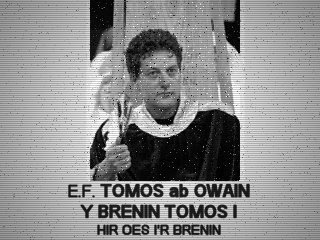 |
Of course, the monarch never dies, and Owain was succeeded by his younger son (his elder son having been killed in a road accident many years before). H.M. Tomos son of Owain, King Tomos I ("Long Live The King") was 31 years of age and considered a quiet, thoughtful sort of man, but with an urge to encourage innovation and initiative amongst his people. |
| It was fitting, then, that a few months later this caption announced to the few hundred enthusiasts in the south of the country who already had sets that the television service would extend to their region from 5 October by means of a transmitter near Y Bont Faen (Cowbridge). | 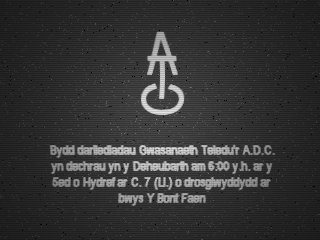 |
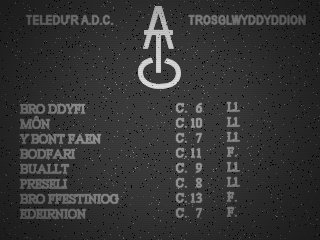 |
ATC's coverage expanded with graceful gradualness for the remainder of the decade, so that by 1970 this caption (shown in the half hour before the beginning of programmes for the evening) was able to boast no fewer than eight transmitters. Interestingly, the only transmitters radiating vertically were in the north east, in order to minimise interference from powerful stations in the north of England. |
| However, plans were already afoot (with the active support of the King) to launch a colour transmission system, as was about to happen in England and Scotland. In contrast to the consensual logjam which characterised the beginning of the original service, Tomos I's influence cut through the crap in short order and, by the Spring of 1973, those with the equipment (and within range of a UHF transmitter) could view all the glories of Test Card F. | 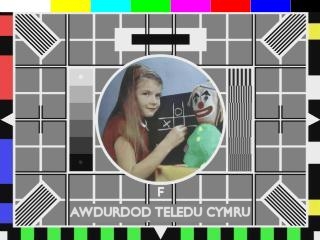 |
 |
The colour service came on air in the September of the same year, and started out with an ident which symbolised continuity (with the ATC logo) and history (with the traditional dragon motif). The dragon was originally designed to spin into place, but this incurred the wrath of a government eager to play the tradition card in the lead-up to an election. The service's Managing Director was summoned for a deeply uncomfortable discussion with the Minister, and the ident stayed static thereafter (as did the MD's career). |
| After a few months, the ident was revamped anyway, with the dragon appearing without the constraints of the box. This didn't look very good at all on black and white VHF sets however, which may have been the point : to encourage the take up of UHF sets which were now being produced by a factory in the southeastern province of Erging by a German company. |  |
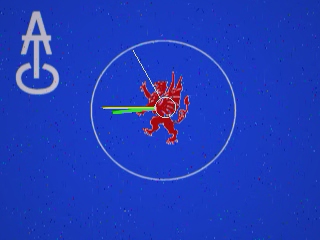 |
Which was just as well, because few would have been enticed by this rather nondescript clock. |
| But you wouldn't even see that on a Sunday. Strictly observing cultural convention (and wary of annoying the religious ethos of the country), ATC didn't broadcast on Sundays. During the Lord's Day, this caption was all that desperate viewers could find, piously telling them that programmes recommenced at 6 p.m. on Monday. | 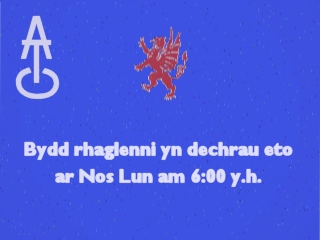 |
 |
Things were allowed to bed in a bit before the next change. In early 1977, the ident (still static, but in a modified style) lost its dragon and turned gold. But this was just the prelude to something far more ambitious. |
So successful had ATC been that it was thought high time to expand into a second channel. This meant that a new identity had to found for the existing one. Not surprisingly, they settled on calling it "Rhaglen 1" (Programme 1).
| The first attempt at re-branding can be seen from this menu. The programming was hardly radically different, though, the opening news programme being followed by a parliamentary report, half an hour of regional programmes (this being the only substantial expansion of programming in the early colour years), the still-running serial, an hour's down-home entertainment, another news programme, a TV adaptation of a play and a nostalgia show, followed by the standard closedown fare of news headlines and a religious meditation. |  |
 |
After a month or two, the Authority realised that a far stronger image had to be created. This led to this rather striking and bold "1", although the old logo still had a presence... |
| ...sometimes. In fact, this was the year which saw the last regular appearance of the old ATC symbol. |  |
 |
Presentation was beefed up a bit, too, although this preview caption for the channel's election night coverage varied little in layout from its monochrome predecessors. |
| And they still had to apologise for technical problems, such as on this particular occasion when the second news programme of the evening was forced off air by a small fire in part of the new Broadcasting Centre on the outskirts of Machynlleth. |  |
 |
But now, you had a choice of viewing. "Rhaglen 2" came on air at the end of the summer. This was the caption seen on its frequencies six days before the launch. |
| Programme 2's initial remit was to broadcast education, the higher arts and serious documentaries (thus, in theory, leaving the fluff to Programme 1, although there remained a strong whiff of the old ethos there for some time). This menu caption from the early days shows this intent clearly, with four 30-minute language classes followed by a half an hour interval when classical music was played over another menu, and then the meaty bits of the evening, starting in this case with "Neither Here Nor There", a political discussion programme. Notice how the rather weak white '2' has been abandoned already. In fact, there were also blue, black and mauve variants, but they were rarely seen beyond the first few months. |  |
 |
In fact, for a period of six weeks in the autumn of 1979, everything was rarely seen on the service apart from this caption ("Because of action by members of the staff of the ATC, there will no broadcasting on Programme 2 tonight"). The technical staff assigned to Programme 2 went on strike over new contracts. They were eventually forced back in under government and public pressure... |
| ...because the influential strata of society who had taken to 2 were highly peeved at merely having an apologetic caption or this test card to look at, and that pressure in the run-up to an election proved telling. |  |
 |
And so the intellectual elite were able once more to enjoy fare such as "Fortresses Of The Giants", a documentary about noted great houses of the realm, such as Sycharth, ancestral home of Glyndŵr. |